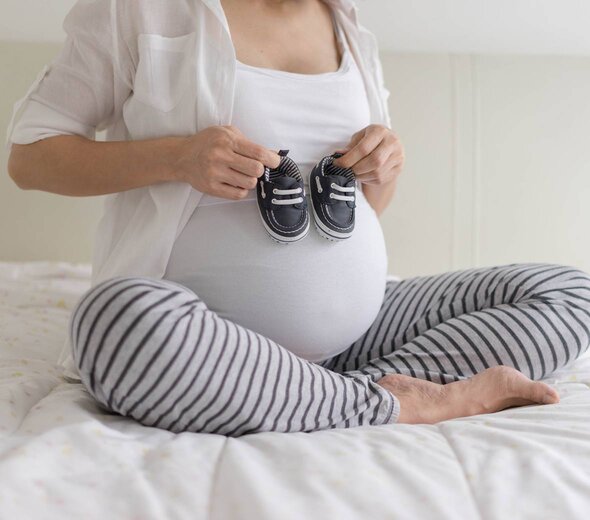

After short improvements of the second trimester, the pregnancy mood swing slowly descends again. Fortunately, each new day brings the mum-to-be closer to the labour, and the extra inches in the waist mean only that the little one inside develops and grows. You will soon be able to enjoy his warmth and closeness during cuddling.
During this time, you may find that even getting out of a chair is sometimes problematic. New body size can make the expectant mother feel increasingly clumsy and unattractive. There may appear stretch marks, rashes, and a dark line on your stomach running from the navel towards the pubic symphysis. This is a physiological phenomenon, which disappears soon after birth.
What is going on inside? Since this month the baby begins to gain weight intensively. His bones harden, lungs develop and fat deposits are forming under the skin. The baby is already 40 cm long and weighs about 1200 g.
Important! During this period, the mum-to-be can suffer from painful leg cramps. This ailment is associated with low levels of magnesium, thus to prevent it it is a good idea to enrich your diet in e.g. groats, banana, avocado, and - as a comfort for the last months of pregnancy - a few lumps of chocolate.
Waiting, pondering and for a change: pondering and waiting. This is more or less what the end of the pregnancy is about. During this time many mums prepare the baby's room at home. The psychologists call this need for activity a "nesting syndrome". For many women the only obstacle to a complete rearranging of the flat is ... a really impressive belly. This is hardly surprising, as in the 36th week of pregnancy the uterus is already a thousand times larger than usual.
What is going on inside? This is the last moment for the child to position himself properly before the delivery. If he does not do that until about 33th -35th week of the pregnancy, then it may be too large to rotate freely in the uterus. At the end of the eighth month the baby already weighs about 2.5 kg. This period is marked by particularly intense development of the brain and senses, e.g. hearing. The little one learns the voice of his mother, and is rocked to sleep by her heart rhythm.
Important! During this period you should think about your childbirth strategy - choose a hospital, consider the anesthesia, decide whether the child's father will be present at the delivery room ... The birth day is coming quickly!
Strange as it seems you can now feel relief. It is easier to breathe, eat, talk, and you rarely get breathless. This is due to lowering of the uterus and reduced pressure on the ribs and lungs. During the last weeks, a woman's body starts intense preparation for the childbirth. Slight swelling may occur (the body stores water). Cervix begins to shorten - mucous plug is slightly pink or brown and all other spotting requires medical advice. When you gently press the breast nipple, the first milk called "colostrum" may appear.
What is going on inside? The child weighs over 3 kg and is already so big that it is slowly running out of space. This is why during the last month the kicking will be far less often than before.
Important! During this period, the mum-to-be can suffer from insomnia. It's mainly due to hormones, but also the belly is so big that is hinders comfortable positioning in the bed. Many women prefer laying on the side, with a small pillow between their knees.
- Blood analysis. During the last month the expectant mother will be referred for syphilis carrier test (called WR), and hepatitis B virus carrier test (called HBsAg).
- Urine analysis. The doctor will check the level of protein in the urine. Elevated protein level plus high blood pressure often mean serious trouble (i.e. gestosis). If tests confirm this diagnosis, a gynecologist may decide on the Caesarean section before the due date. But this is not a rule - physiological labour in women with this disorder is also possible.
- Ultrasound examination (third). It allows the doctor to determine the amount of amniotic fluid and the position of the child in the womb, which can affect the type of delivery. He can also assess the size and approximate weight of the child.
- Vaginal culture. In case of the streptococcus presence, antibiotics are administered to the mother at the onset of the labour and continued until it ends. Pediatrician decides whether the baby is given the antibiotic as well. The time from the membrane rupture to the childbirth is also taken into account.
- CTG By monitoring your baby's heart rate the doctor knows his or her condition. Too slow heart rate may indicate fetal hypoxia, too fast - an intrauterine infection.